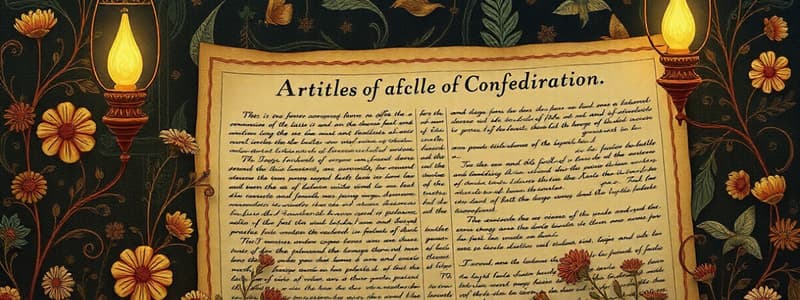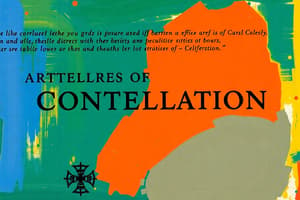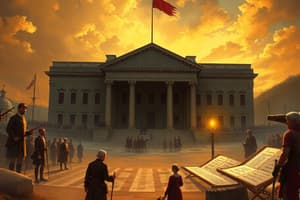Podcast
Questions and Answers
What was the main objection of the Anti-Federalists to the Constitution?
What was the main objection of the Anti-Federalists to the Constitution?
- They believed the Constitution was too similar to the Articles of Confederation.
- They believed the Constitution was too complex and difficult to understand.
- They believed the Constitution would give too much power to the states.
- They believed the Constitution gave too much power to the national government. (correct)
Which of the following groups were primarily supporters of the Constitution?
Which of the following groups were primarily supporters of the Constitution?
- Farmers and rural people
- Women
- Bankers and merchants (correct)
- Native Americans
What was the purpose of the Federalist Papers?
What was the purpose of the Federalist Papers?
- To propose amendments to the Constitution.
- To convince state legislatures to ratify the Constitution. (correct)
- To provide a detailed explanation and interpretation of the Constitution.
- To argue against the inclusion of a Bill of Rights in the Constitution.
What was the main reason the Anti-Federalists insisted on a Bill of Rights?
What was the main reason the Anti-Federalists insisted on a Bill of Rights?
Which of the following groups were NOT explicitly protected by the Bill of Rights?
Which of the following groups were NOT explicitly protected by the Bill of Rights?
Which of the following was NOT a power of the Unicameral Legislature (Congress) under the Articles of Confederation?
Which of the following was NOT a power of the Unicameral Legislature (Congress) under the Articles of Confederation?
What was the significance of the Land Ordinance of 1785?
What was the significance of the Land Ordinance of 1785?
What was a significant weakness of the Articles of Confederation in terms of its structure?
What was a significant weakness of the Articles of Confederation in terms of its structure?
What was the main reason Congress struggled to repay debts from the Revolutionary War under the Articles of Confederation?
What was the main reason Congress struggled to repay debts from the Revolutionary War under the Articles of Confederation?
How did the Articles of Confederation address the admission of new states to the union?
How did the Articles of Confederation address the admission of new states to the union?
Which of the following was a major challenge faced by the government under the Articles of Confederation?
Which of the following was a major challenge faced by the government under the Articles of Confederation?
What was one of the main reasons the Articles of Confederation were considered too rigid?
What was one of the main reasons the Articles of Confederation were considered too rigid?
How did the Articles of Confederation reflect the ideals of the American Revolution?
How did the Articles of Confederation reflect the ideals of the American Revolution?
What was the original goal of the Constitutional Convention?
What was the original goal of the Constitutional Convention?
Which plan proposed a unicameral legislature with equal representation for each state?
Which plan proposed a unicameral legislature with equal representation for each state?
Which branch of government is responsible for interpreting laws?
Which branch of government is responsible for interpreting laws?
Which proposal addressed concerns about representation based on state population?
Which proposal addressed concerns about representation based on state population?
According to the 3/5ths Compromise, how were enslaved people counted for purposes of representation and taxation?
According to the 3/5ths Compromise, how were enslaved people counted for purposes of representation and taxation?
What was the outcome of the debate concerning the international slave trade?
What was the outcome of the debate concerning the international slave trade?
Which of these was NOT a factor that contributed to Shays' Rebellion?
Which of these was NOT a factor that contributed to Shays' Rebellion?
Why did the Framers of the Constitution decide to create a system of checks and balances among the three branches of government?
Why did the Framers of the Constitution decide to create a system of checks and balances among the three branches of government?
Flashcards
Articles of Confederation
Articles of Confederation
The first constitution of the US, establishing a unicameral legislature.
Unicameral legislature
Unicameral legislature
A single-chamber legislative body where each state has one vote.
Strengths of Articles
Strengths of Articles
Successes included winning the Revolutionary War and land ordinances.
Weaknesses of Articles
Weaknesses of Articles
Signup and view all the flashcards
Wage war
Wage war
Signup and view all the flashcards
Shays' Rebellion
Shays' Rebellion
Signup and view all the flashcards
Northwest Ordinance of 1787
Northwest Ordinance of 1787
Signup and view all the flashcards
Treaty of Paris 1783
Treaty of Paris 1783
Signup and view all the flashcards
Constitutional Convention
Constitutional Convention
Signup and view all the flashcards
Virginia Plan
Virginia Plan
Signup and view all the flashcards
New Jersey Plan
New Jersey Plan
Signup and view all the flashcards
The Great Compromise
The Great Compromise
Signup and view all the flashcards
3/5ths Compromise
3/5ths Compromise
Signup and view all the flashcards
Federalists
Federalists
Signup and view all the flashcards
Anti-Federalists
Anti-Federalists
Signup and view all the flashcards
Bill of Rights
Bill of Rights
Signup and view all the flashcards
Limitations of the Bill of Rights
Limitations of the Bill of Rights
Signup and view all the flashcards
Great Compromise
Great Compromise
Signup and view all the flashcards
Study Notes
Early US Governments
- The initial US government, the Articles of Confederation, had a unicameral (one-house) legislature where each state had one vote, no executive branch, and no judicial branch.
- By 1781, all 13 states ratified the Articles of Confederation.
- Congress under the Articles could wage war, send/receive ambassadors, create treaties, and borrow money.
- However, Congress could not enforce laws, regulate commerce, or collect taxes. This led to significant financial problems.
- The Articles had strengths, including negotiating favorable terms in the Treaty of Paris (1783) and establishing the Northwest Ordinance of 1787, which outlined rules for settling and creating new territories.
Weaknesses of the Articles of Confederation
- The Articles lacked the power to tax, regulate trade, and enforce laws.
- The lack of a national currency and inability to repay foreign debts.
- There was no central leadership (no executive branch); states were not required to follow the Articles.
- Rules were rigid, requiring 9 states to agree on legislation and all 13 to change the Articles. This made it difficult to respond to national issues and to make changes.
Shay's Rebellion
- Capt. Daniel Shays, a Massachusetts farmer and Revolutionary War veteran, led an uprising against high state taxes, imprisonment for debt, and lack of paper money.
- The rebellion highlighted the weaknesses of the Articles of Confederation.
Constitutional Convention of 1787
- The initial goal was to revise the Articles of Confederation.
- All 13 states sent delegates to Philadelphia.
- George Washington was unanimously elected to preside over the convention.
- The convention's goal shifted to creating a new constitution with a stronger federal government.
Constitutional Convention Questions
- The convention debated the structure of government, the issue of slavery, and how the President should be elected.
Proposed Solutions
- Virginia Plan: Proposed a three-branch government (executive, legislative, judicial). The legislature would be bicameral (two houses) with representation based on state population. This favored larger states.
- New Jersey Plan: Also proposed a three-branch government. However, the legislature would be unicameral (one house) with each state having one vote, regardless of size. This favored smaller states.
The Great Compromise
- Also known as the Connecticut Compromise, this plan combined elements of both the Virginia and New Jersey plans.
- It created a three-branch government, with a bicameral legislature.
- The House of Representatives has representation based on state population, while the Senate has equal representation for every state (two senators per state).
Checks and Balances
- The US Constitution established a system of checks and balances to prevent any one branch of government from becoming too powerful. Each branch has ways to limit the power of the others.
Federalism
- The US government is a federal system, dividing powers between the national, state, and local levels.
Issues over Slavery at the Convention
- Should enslaved people be counted in state populations for representation?
- Result: The Three-Fifths Compromise, allowing enslaved people to be counted as 3/5 of a person for representation and taxation purposes.
- Should the international slave trade continue?
- Result: Congress agreed to allow the international slave trade until 1808 but could then vote to abolish the practice.
Federalists vs. Anti-Federalists
- Federalists: supporters of the Constitution, including bankers and merchants who favored a strong national government with a strong executive branch. They often used the Federalist Papers to try to convince people to support the Constitution.
- Anti-Federalists: opposed the Constitution, favoring weaker national government and stronger state governments and often pushing for a Bill of Rights.
Bill of Rights
- Many states feared that the changes proposed for the Constitution would harm their individual liberties.
- In September 1789, Congress submitted 12 amendments, and by December 1791, 10 of them were ratified as the Bill of Rights, outlining individual rights.
Limitations of the Bill of Rights
- The Bill of Rights did not apply to all Americans. Native Americans and women were not initially included, and protections did not apply to racial discrimination against enslaved (or free) Black people.
Final Thoughts
- The US Constitution was adopted. However, the new nation needed a president, a court system, and to evaluate foreign relations.
- The early years of the US were formative, and the first presidents’ actions significantly shaped the nation's development.
Studying That Suits You
Use AI to generate personalized quizzes and flashcards to suit your learning preferences.




